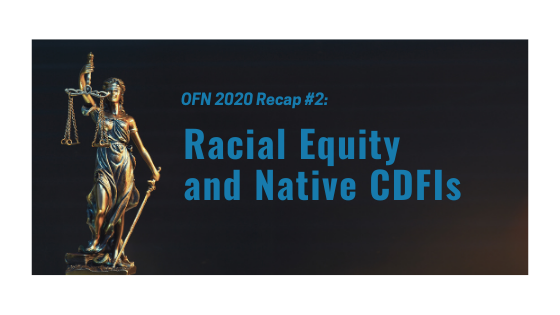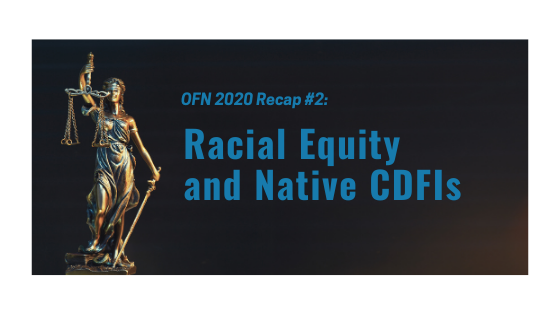OFN Recap #2: Racial Equity and Native CDFIs
December 2, 2020 •James Hargens

Summit’s mission-oriented finance team recently attended the annual Opportunity Finance Network conference from November 9 to November 12, 2020. Due to ongoing concerns around the COVID-19 pandemic, the conference was held in a virtual format for the first time in its history. In total, the Summit team attended 41 breakout sessions over the four-day conference. These sessions covered different aspects of the community development financial institution (CDFI) industry related to the conference’s overall theme of finance justice. This three-part blog series discusses the highlights and key takeaways from the conference’s main themes:
Part 1: Capitalization, public policy, and financingPart 2: Racial equity and native CDFIs
Part 3: CDFI sustainability and resilience
Racial Equity
Since its inception in the 1990s, the CDFI industry has invested billions of dollars into underserved communities and leveraged even more funding, collectively growing to more than 1,100 CDFIs totaling more than $135 billion in assets. Despite this unprecedented level of investment and the expansion of lending and support programs to more low-income communities, racial inequality and injustice persists throughout the country. To expand their impact and address these inequities laid bare by the COVID-19 pandemic and nationwide protests, CDFIs are doubling down to intentionally position their work in an anti-racist framework by looking both internally and externally. As communities, stakeholders, and CDFIs make the case to funders and government agencies for more targeted investment to address systemic inequities, quantifying racial-equity impact through clear and measurable criteria is more important than ever. A well-defined framework for analyzing investment impact helps CDFIs collect more useful data on the investments they make, helping organizations further improve equity in lending practices and policies.
Increasing investment in underserved communities is only half of the equation. A commitment to organizational learning around racial equity has informed many CDFI programs that utilize a holistic approach to addressing systemic inequities. A two-and-a-half-year partnership between Nonprofit Finance Fund and Capital Impact Partners called Catalyzing Finance for Racial Equity will examine how social determinants of health can promote equitable outcomes in communities and inform future programs. Capital Impact Partners has also championed the Equitable Development Initiative, a cohort-based program in Washington, D.C., and Detroit to provide local minority developers with training, technical assistance, and mentorship. The program has more than 100 graduates to date and promises to build a pipeline of successful developers and community-development practitioners for years to come.
Native CDFIs
Native-led CDFIs provide critical financial resources and other services within Native communities. Because these communities are often located in rural areas, low-income Native households face difficulties accessing long-term, low-cost financing and support services found in more urban areas. The recent COVID-19 pandemic exacerbated these resource gaps, with American Indians and Alaska Natives three and a half times more likely to test positive for the virus according to an August 2020 report from the Centers for Disease Control. These statistics serve as another example of the historical economic segregation that Native communities have faced for decades. Despite these challenges, Native CDFIs champion a model of resiliency that leverages relationships with federal government agencies, local community members, businesses, and other Native CDFIs to make an impact.
Federal programs like the USDA Section 502 Guaranteed Loan Program and HUD Section 184 Indian Home Loan Guarantee Program for single-family homeownership and home repair enable this rural lending activity. The Section 502 program guarantees up to 100% of the home purchase, covers closing costs, and does not require a down payment, making it particularly attractive to borrowers. Despite these terms, there are no Native CDFIs approved as a Section 502 lender. By comparison, the HUD Section 184 program provides full guarantees to borrowers of federally recognized tribal communities. As lender-driven loan guarantee programs, both require that CDFI lenders provide the loan capital up front.
Check out the 2020 OFN Virtual Conference recap site to explore the official conference content for free.
Get Updates
Featured Articles
Categories
- affordable housing (12)
- agile (3)
- AI (4)
- budget (3)
- change management (1)
- climate resilience (5)
- cloud computing (2)
- company announcements (15)
- consumer protection (3)
- COVID-19 (7)
- data analytics (82)
- data science (1)
- executive branch (4)
- fair lending (13)
- federal credit (35)
- federal finance (6)
- federal loans (6)
- federal register (2)
- financial institutions (1)
- Form 5500 (5)
- grants (1)
- healthcare (17)
- impact investing (12)
- infrastructure (13)
- LIBOR (4)
- litigation (8)
- machine learning (2)
- mechanical turk (3)
- mission-oriented finance (7)
- modeling (9)
- mortgage finance (10)
- office culture (26)
- opioid crisis (5)
- Opportunity Finance Network (4)
- opportunity zones (12)
- partnership (15)
- pay equity (5)
- predictive analytics (15)
- press coverage (3)
- program and business modernization (7)
- program evaluation (29)
- racial and social justice (8)
- real estate (2)
- risk management (10)
- rural communities (9)
- series - loan monitoring and AI (4)
- series - transforming federal lending (2)
- strength in numbers series (9)
- summer interns (7)
- taxes (7)
- thought leadership (3)
- white paper (15)




